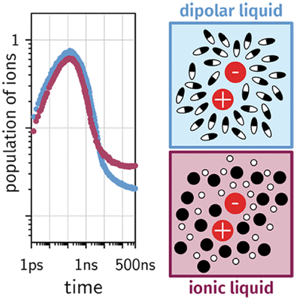Bimolecular photoinduced electron transfer between perylene and two quenchers was investigated in an imidazolium room-temperature ionic liquid (RTIL) and in a dipolar solvent mixture of the same viscosity using transient absorption on the subpicosecond to submicrosecond time scales. Whereas charge separation dynamics were similar in both solvents, significant differences were observed in the temporal evolution of the ensuing radical ions: although small, the free-ion yield is significantly larger in the RTIL, and recombination of the ion pair to the triplet state of perylene is more efficient in the dipolar solvent. The temporal evolution of reactant, ion, and triplet state populations could be well reproduced using unified encounter theory. This analysis reveals that the observed differences can be explained by the strong screening of the Coulomb potential in the ion pair by the ionic solvent. In essence, RTILs favor free ions compared to highly dipolar solvents of the same viscosity. |



